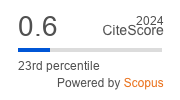The effect of nitric oxide (II) on the extracellular matrix of the lungs during cardiopulmonary bypass: an experimental study
https://doi.org/10.29001/2073-8552-2025-40-3-178-187
Abstract
Cardiac surgeries with cardiopulmonary bypass (CBP) lead to significant changes in the morphofunctional state of the lungs, accompanied by the formation of post-perfusion pulmonary syndrome. Reperfusion significantly increases lung damage due to the influx of oxygen and calcium ions, as well as leukocytes and blood clotting system components activated by contact with the apparatus circuit material. Cells of the inflammatory infiltrate damage matrix proteins by releasing proteolytic enzymes that damage the structure of collagen and elastin and lead to the formation of their modified forms with altered spatial organization and mechanical properties. Nitric oxide (II) (NO) has the potential to affect the key pathogenic mechanisms of ischemic-reperfusion damage. Under cardiopulmonary bypass, there is a deficiency of endogenous nitric oxide, so perioperative delivery of exogenous NO is likely to compensate for this deficiency.
Aim: To characterize the changes occurring in the intercellular matrix of the lungs under the conditions of simulated surgeries with cardiopulmonary bypass and the effect of perioperative delivery of nitric oxide on their severity.
Material and Methods. The study was conducted on 6 male domestic sheep. The animals of the “CBP” group (n = 3) underwent CBP and mechanical ventilation (MV) according to the standard procedure. In the “CBP + NO” group (n = 3), sheep additionally received nitric oxide (II) at a dose of 80 ppm through modified circuits of ventilators and cardiopulmonary bypass throughout the experiment. The duration of cardiopulmonary bypass was 90 minutes. The content of matrix metalloproteinases-2 and -9 in the lungs was assessed by immunohistochemistry. Collagen fibers were detected by Van – Gieson staining and an immunohistochemical reaction to type I collagen.
Results. In the lungs of sheep treated with nitric oxide on the background of cardiopulmonary bypass, a decrease in the intensity of immune staining for MMP-2 (p < 0.001) and MMP-9 (p < 0.001), higher specific volume (p < 0.001) and qualitative characteristics of collagen fibers were noted.
Conclusion. The use of nitric oxide in experimental modeling of cardiac surgery helps to limit the damaging effect of cardiopulmonary bypass on the intercellular matrix of the lungs.
Keywords
About the Authors
E. A. GerengRussian Federation
Elena A. Gereng - Dr. Sci. (Med.), Associate Professor, Professor of the
Department of Morphology and General Pathology, SSMU.
2, Moskovsky trakt, Tomsk, 634050
I. V. Milto
Russian Federation
Ivan V. Milto - Dr. Sci. (Biol.), Associate Professor, Head of the Department of Morphology and General Pathology, SSMU.
2, Moskovsky trakt, Tomsk, 634050
O. N. Serebryakova
Russian Federation
Olga N. Serebryakova - Assistant, Department of Morphology and General Pathology, SSMU.
2, Moskovsky trakt, Tomsk, 634050
A. N. Dzuman
Russian Federation
Anna N. Dzyuman - Cand. Sci. (Med.), Associate Professor, Department of Morphology and General Pathology, SSMU.
2, Moskovsky trakt, Tomsk, 634050
M. A. Byankina
Russian Federation
Maria A. Biankina - Sixth-year student, Faculty of Medicine and Biology, SSMU.
2, Moskovsky trakt, Tomsk, 634050
A. V. Potapov
Russian Federation
Alex V. Potapov - Dr. Sci. (Med.), Professor, Department of Histology, Cytology and Embryology, SSMU.
2, Moskovsky trakt, Tomsk, 634050
N. O. Kamenshikov
Russian Federation
Nikolay O. Kamenshchikov - Cand. Sci. (Med.), Head of the Laboratory of Critical Condition Medicine, Cardiology Research Institute.
111a, Kievskaya str., Tomsk, 634012
I. V. Kravchenko
Russian Federation
Igor V. Kravchenko - Junior Research Scientist, Laboratory of Critical Care Medicine, Cardiology Research Institute.
111a, Kievskaya str., Tomsk, 634012
Yu. K. Podoksenov
Russian Federation
Yuri K. Podoksenov - Dr. Sci. (Med.), Senior Research Scientist, Department of Cardiovascular Surgery, Senior Research Scientist, Laboratory of Critical Care Medicine, Cardiology Research Institute.
111a, Kievskaya str., Tomsk, 634012
V. E. Alyamkin
Russian Federation
Vadim E. Alyamkin - Clinical Resident, Department of Cardiovascular Surgery, Cardiology Research Institute, Tomsk NRMC.
111a, Kievskaya str., Tomsk, 634012
References
1. Fischer M.O., Brotons F., Briant A.R., Suehiro K., Gozdzik W., Sponholz C. et al. Postoperative pulmonary complications after cardiac surgery: The VENICE International Cohort Study. J. Cardiothorac. Vasc. Anesth. 2022;36(8):2344–2351. https://doi.org/10.1053/j.jvca.2021.12.024.
2. Yuan S.M. Postperfusion lung syndrome: physiopathology and therapeutic options. Rev. Bras. Cir. Cardiovasc. 2014;29(3):414–425. https://doi.org/10.5935/1678-9741.20140071.
3. Ferrari R.S., Andrade C.F. Oxidative Stress and Lung IschemiaReperfusion Injury. Oxid. Med. Cell Longev. 2015;2015:590987. https://doi.org/10.1155/2015/590987.
4. Giacinto O., Satriano U., Nenna A., Spadaccio C., Lusini M., Mastroianni C. et al. Inflammatory response and endothelial dysfunction following cardiopulmonary bypass: pathophysiology and pharmacological targets. Recent Pat. Inflamm. Allergy Drug. Discov. 2019;13(2):158–173. https://doi.org/10.2174/1872213X13666190724112644.
5. Wang S. Friffith B.P., B.P., Wu Z.J. Device-Induced Hemostatic Disorders in Mechanically Assisted Circulation. Clin. Appl. Thromb. Hemost. 2021;27:1076029620982374. https://doi.org/10.1177/1076029620982374.
6. Ta H.Q., Kuppusamy M., Sonkusare S.K., Roeser M.E., Laubach V.E. The endothelium: gatekeeper to lung ischemia-reperfusion injury. Respir. Res. 2024;25(1):172. https://doi.org/10.1186/s12931-024-02776-4.
7. Kulikov O.A., Balashov V.P., Ageev V.P., Semenova E.V., Shljapkina V.I., Zamyshljaev P.S. The morphology of the lungs at the experimental acute injury and its pharmacocorrection. Morfologicheskie Vedomosti – Morphological Newsletter. 2020;28(2):64–73. (In Russ.). https://doi.org/10.20340/mv-mn.2020.28(2):64-73.
8. Kamenshchikov N.O., Podoksenov Y.K., Kozlov B.N., Maslov L.N., Mukhomedzyanov A.V., Tyo M.A. et al. Potential mechanisms for organoprotective effects of exogenous nitric oxide in an experimental study. Biomedicines. 2024;12(6):12. https://doi.org/10.3390/biomedicines12061298
9. Yan Y., Kamenshchikov N., Zheng Z., Lei C. Inhaled nitric oxide and postoperative outcomes in cardiac surgery with cardiopulmonary bypass: A systematic review and meta-analysis. Nitric Oxide. 2024;146:64–74. https://doi.org/10.1016/j.niox.2024.03.004.
10. Andrabi S.M., Sharma N.S., Karan A., Shatil S.M., Cordon B., Ma B. et al. Nitric Oxide: Physiological Functions, Delivery, and Biomedical Applications. Adv. Sci. (Weinh). 2023;10(30):e2303259. https://doi.org/10.1002/advs.202303259.
11. Bhirowo Y.P., Raksawardana Y.K., Setianto B.Y., Sudadi S., Tandean T.N., Zaharo A.F. et al. Hemolysis and cardiopulmonary bypass: meta-analysis and systematic review of contributing factors. J. Cardiothorac. Surg. 2023;18(1):291. https://doi.org/10.1186/s13019023-02406-y.
12. Baidoo N., Crawley E., Knowles C.H., Sanger G.J., Belai A. Total collagen content and distribution is increased in human colon during advancing age. PLoS One. 2022;17(6):e0269689. https://doi.org/10.1371/journal.pone.0269689.
13. Prutkina E.V., Sepp A.V., Cybikov N.N. Peculiarities of synthesis of matrix metalloproteinase-9 in the lungs during experimental development of distress syndrome. Acta Biomedica Scientifica. 2013;1(89):121–124. (In Russ.). URL: https://www.actabiomedica.ru/jour/article/view/1417/1364 (08.09.2025).
14. Kamenshchikov N.O., Safaee Fakhr B., Kravchenko I.V., Dish A.Y., Podoksenov Y.K., Kozlov B.N. et al. Assessment of continuous lowdose and high-dose burst of inhaled nitric oxide in spontaneously breathing COVID-19 patients: A randomized controlled trial. Nitric Oxide. 2024;149:41–48. https://doi.org/10.1016/j.niox.2024.06.003.
15. Zhou P., Song N.C., Zheng Z.K., Li Y.Q., Li J.S. MMP2 and MMP9 contribute to lung ischemia-reperfusion injury via promoting pyroptosis in mice. BMC Pulm. med. 2022;22(1):230. https://doi.org/10.1186/s12890022-02018-7.
16. Grigorkevich O.S., Mokrov G.V., Kosova L.Ju. Matrix metalloproteinases and their inhibitors. Farmakokinetika i farmakodinamika. 2019;2:3–16. (In Russ.). https://doi.org/10.24411/2587-7836-2019-10040.
17. Qu L.C., Jiao Y., Jiang Z.J., Song Z.P., Kang L., Peng Q.H. Expression pattern of matrix metalloproteinase 9 in ischemia-reperfusion-induced acute lung injuries. Int. J. Clin. Exp. Med. 2018;11(11):12048–12058. ISSN:1940-5901/IJCEM0080064.
18. Smigiel K.S., Parks W.S. Matrix Metalloproteinases and Leukocyte Activation. Prog. Mol. Biol. Transl. Sci. 2017;147:167–195. https://doi.org/10.1016/bs.pmbts.2017.01.003.
19. Waldow T., Witt W., Buzin A., Ulmer A., Matschke K. Prevention of ischemia/reperfusion-induced accumulation of matrix metalloproteinases in rat lung by preconditioning with nitric oxide. J. Surg. Res. 2009;152(2):198–208. https://doi.org/10.1016/j.jss.2008.03.014.
20. Prado A.F., Batista R.M., Tanus-Santos J.E., Gerlach R.F. Matrix Metalloproteinases and Arterial Hypertension: Role of Oxidative Stress and Nitric Oxide in Vascular Functional and Structural Alterations. Biomolecules. 2021;11(4):585. https://doi.org/10.3390/biom11040585.
Review
For citations:
Gereng E.A., Milto I.V., Serebryakova O.N., Dzuman A.N., Byankina M.A., Potapov A.V., Kamenshikov N.O., Kravchenko I.V., Podoksenov Yu.K., Alyamkin V.E. The effect of nitric oxide (II) on the extracellular matrix of the lungs during cardiopulmonary bypass: an experimental study. Siberian Journal of Clinical and Experimental Medicine. 2025;40(3):178-187. (In Russ.) https://doi.org/10.29001/2073-8552-2025-40-3-178-187





.png)





























